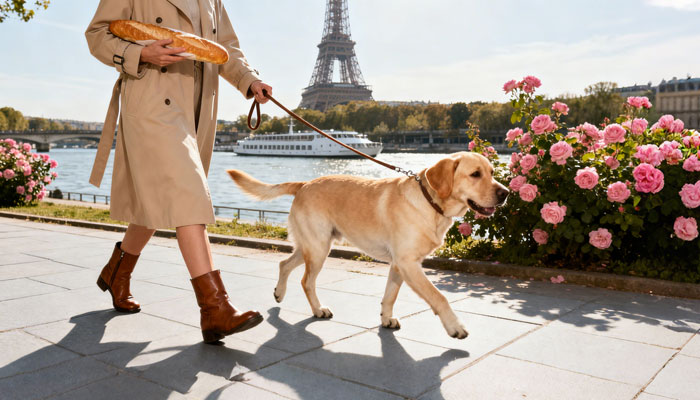Dog Training: How to Train Your Dog to Heel

When walking with their owner, if a dog ignores commands and runs ahead, dog training becomes essential. Focusing specifically on follow-along training helps dogs obey commands better and ensures safety during outings.
I. Dog Training: Indoor Heel Work
Kneel beside your seated puppy. Hold the collar firmly with one hand while using the other to present a tasty treat to capture its attention. Call its name—this forms the foundational guidance step for indoor heel training.
Place the treat just in front of the puppy’s nose and command “Heel!” while walking straight ahead. The food’s scent will entice the puppy to follow. Keep your free hand low, ready to grasp the collar if the puppy tries to wander off. When you stop, command “Stay.” This reinforces the puppy’s response to the “stop” command, a crucial step in command memorization during dog training.
Lower the food to prevent the puppy from jumping up. Then bend your knees and turn right, moving the food in front of you as you pivot while repeating the “heel” command. The puppy will immediately quicken its pace to stay beside you, closely following the treat. This exercise enhances the puppy’s ability to track your direction while moving, forming part of dynamic coordination training in dog training.
When the puppy is still on your left side, command “Stay,” then bring the treat close to its mouth and move leftward. The puppy will follow your steps. Repeat this exercise several times, but keep each session brief (5-10 minutes recommended to prevent fatigue). Reward the puppy with the treat after each session—positive reinforcement is vital for boosting motivation in dog training.
Dog Training: Outdoor Heel Work
Outdoor environments present numerous distractions, making timely correction of the dog’s behavior essential during outdoor heel training. First, when the dog pulls the leash in a certain direction, immediately and firmly guide it in the opposite direction. You can make turns or walk back and forth along the same path. The core principle is that the owner leads the dog, making it understand “the walking direction is determined by the owner.”
Second, the moment the dog prepares to pull forward, observe its readiness signs (e.g., leaning forward, tensing paws). When these signs appear, abruptly pull the leash backward to tighten it against the dog’s neck. The intensity and timing of this action are crucial—apply just enough force to signal a warning without causing harm. The sudden pressure on the dog’s neck followed by immediate leash release creates a conditioned response: “Pulling causes discomfort, while following the owner brings no pressure.” This is the key technique for correcting pulling behavior in outdoor dog training.
However, it’s vital to note that if the leash remains constantly taut around the dog’s neck, this training method becomes ineffective. Sustained tension desensitizes the dog to the pressure, diminishing its sensitivity to the “pulling” behavior. This is an easily overlooked detail in outdoor dog training.
Once your dog learns to walk in harmony through outdoor follow-training, your walks together become a true pleasure. Dog training not only improves your dog’s behavior but also deepens the trust and rapport between you and your canine companion.
admin
-
Sale!

Washable Pet Cooling Pad for Cats and Dogs
$10.99Original price was: $10.99.$9.99Current price is: $9.99. This product has multiple variants. The options may be chosen on the product page -
Sale!

Washable Cat Window Hammock Cooling Bed
$23.99Original price was: $23.99.$22.99Current price is: $22.99. -
Sale!

Tropical Amphibian Rainforest Tank, Lizard Cage
$38.99Original price was: $38.99.$36.99Current price is: $36.99. -
Sale!

Silent 4-in-1 Waterproof Charging Dog Hair Trimmer
$49.88Original price was: $49.88.$47.99Current price is: $47.99.